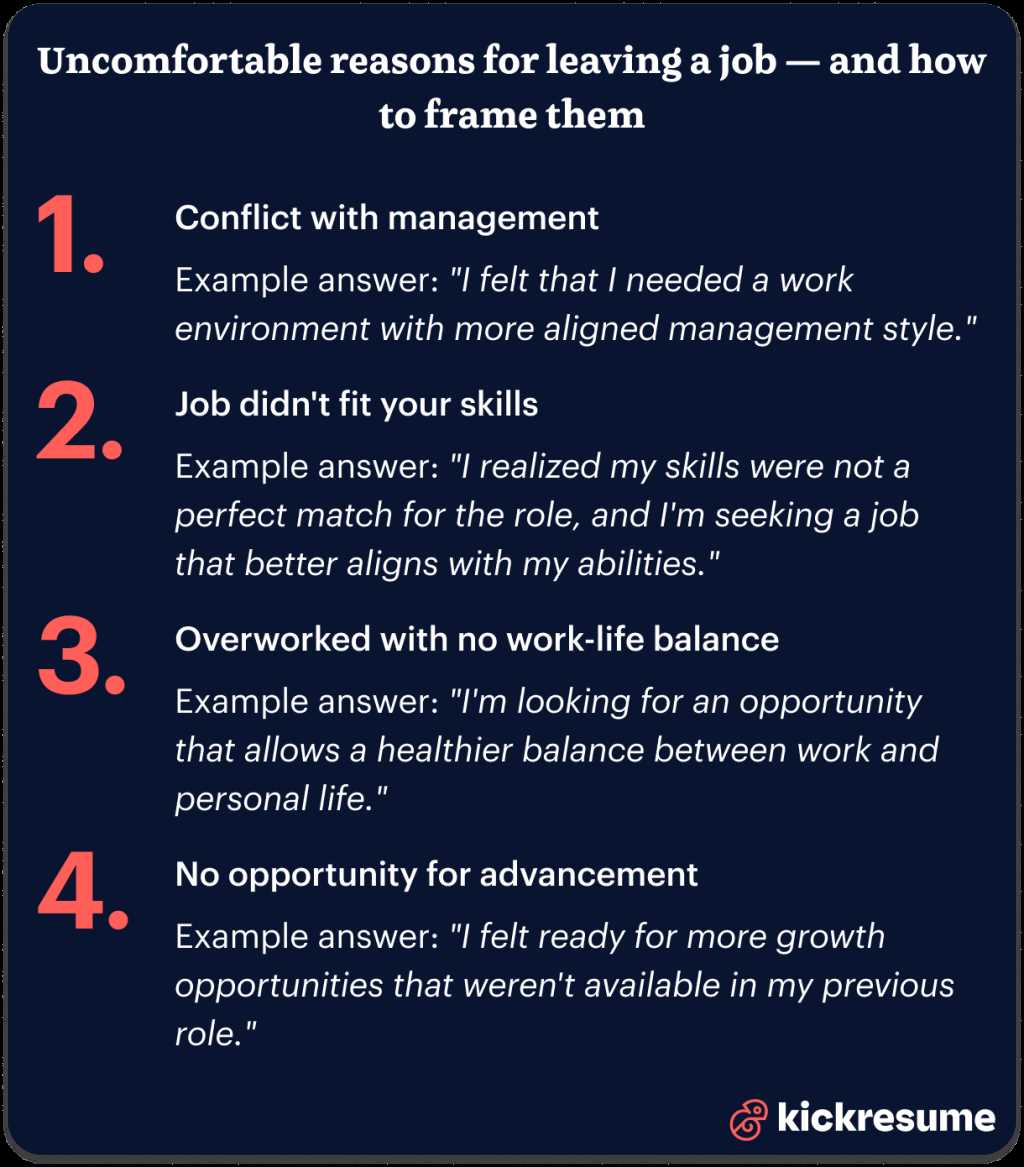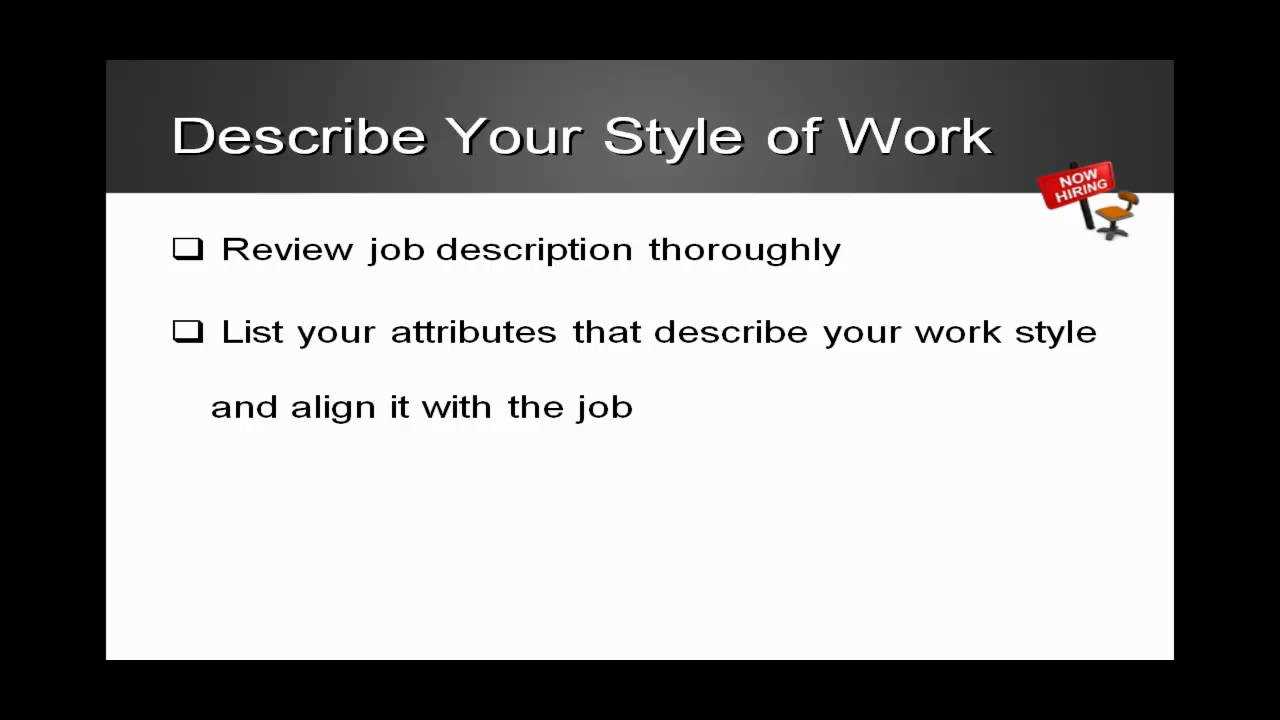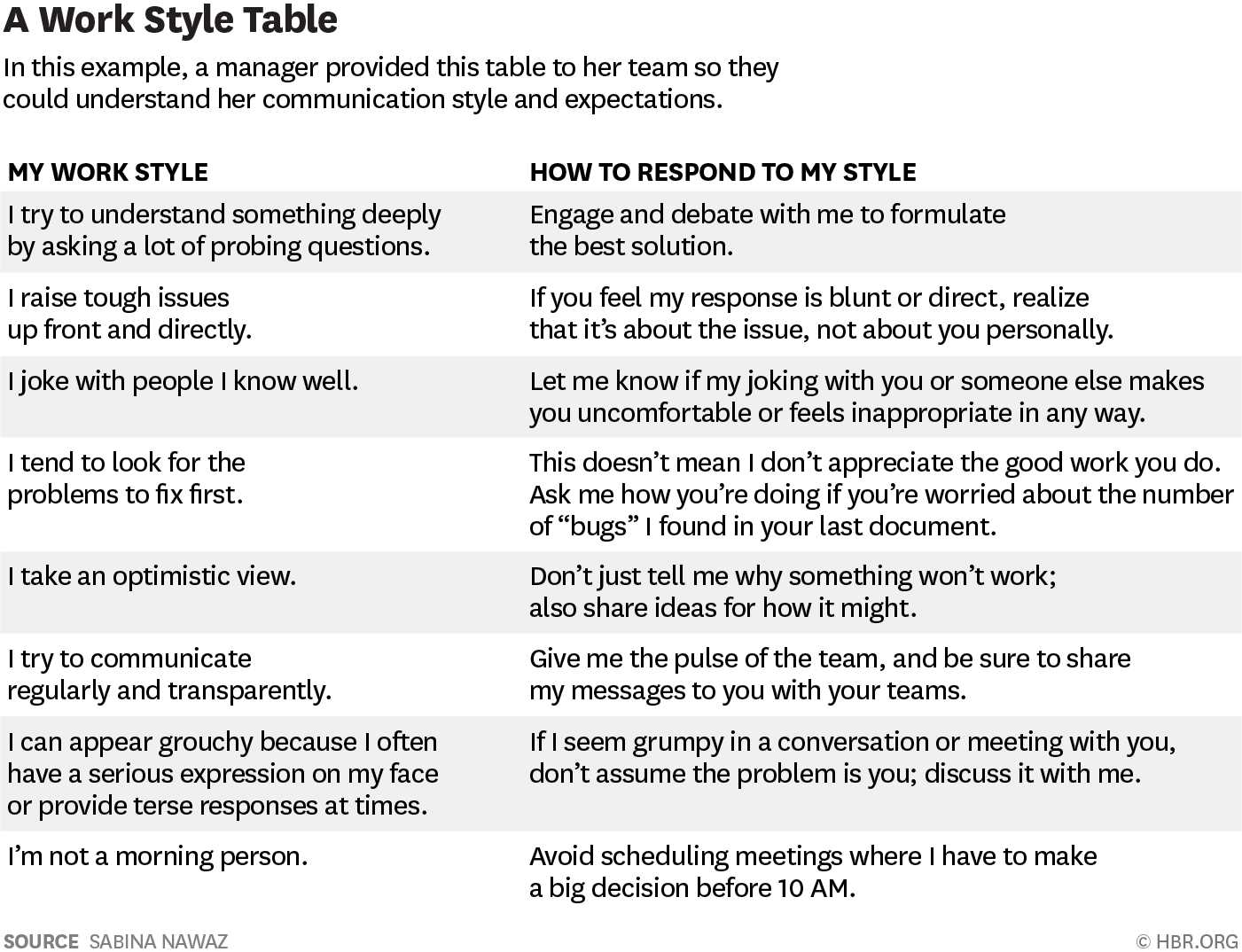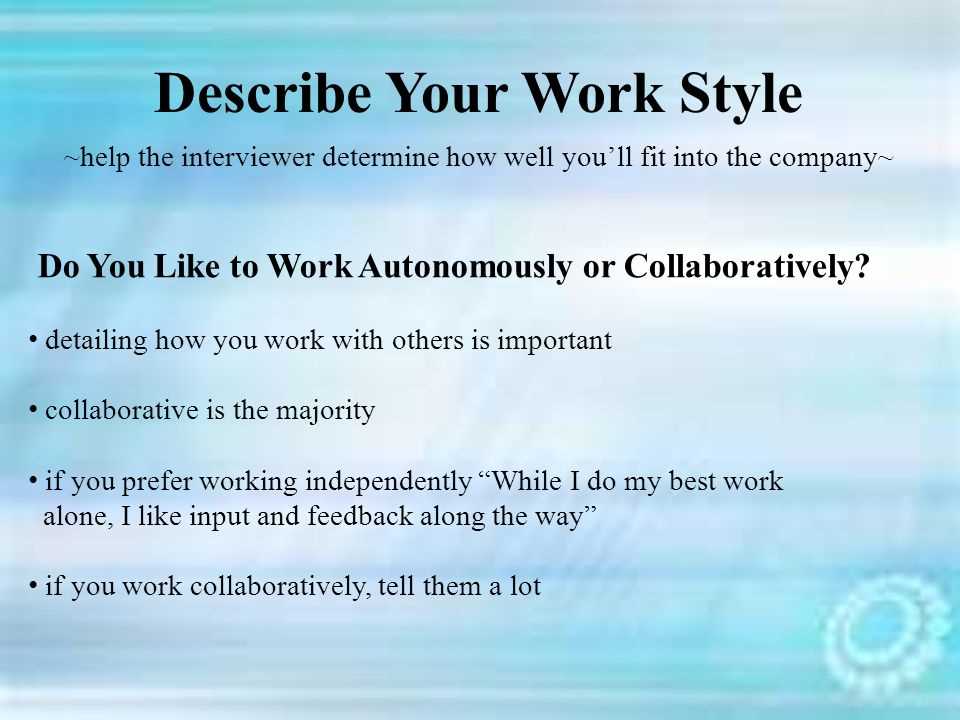
In every professional setting, individuals bring unique methods to complete tasks, collaborate with teams, and navigate challenges. Employers often seek insights into how candidates handle different situations, focusing on behaviors and preferences that impact efficiency and success. Expressing this in interviews or assessments helps demonstrate adaptability, communication skills, and problem-solving capabilities.
By reflecting on key aspects like time management, teamwork, and decision-making processes, individuals can effectively showcase their strengths. It’s important to communicate how personal traits align with organizational goals and how one can contribute to achieving success in the role. Emphasizing flexibility, responsibility, and approach to collaboration can leave a lasting impression on potential employers.
What Is Your Work Style Sample Answer
In a professional setting, employers seek to understand how individuals approach tasks and interact with colleagues. The ability to articulate personal methods for handling responsibilities, collaborating with others, and staying organized is critical. This section will explore how to effectively respond to questions about one’s general approach to tasks and team dynamics.
Common Approaches in a Professional Environment
Every person has a unique method when it comes to managing their duties and interacting within a team. Some prefer a structured and systematic approach, while others thrive in more flexible, dynamic environments. Recognizing these differences is key when answering questions about how you perform in various professional scenarios.
| Approach | Key Characteristics | Example Response |
|---|---|---|
| Organized and Detail-Oriented | Focuses on planning, structure, and thoroughness | “I prioritize tasks by importance and deadlines, ensuring each detail is addressed carefully.” |
| Flexible and Adaptable | Thrives in dynamic, changing environments | “I adapt quickly to new tasks and changes, maintaining focus on overall goals while being open to new methods.” |
| Collaborative | Prefers working with others and sharing ideas | “I believe in leveraging team strengths to achieve optimal outcomes through effective communication.” |
| Independent | Works well with minimal supervision | “I am self-motivated and comfortable making decisions on my own to meet deadlines.” |
Effective Ways to Describe Your Approach
When describing your professional approach, it’s important to balance personal preferences with an understanding of how those traits contribute to the success of the team and organization. By providing specific examples, such as how you manage time or handle challenges, you offer a more comprehensive view of your potential as a candidate.
Understanding the Importance of Work Style
In any professional environment, understanding how individuals approach tasks and interact with teams plays a crucial role in determining job success and team dynamics. Each person has a unique set of preferences, strengths, and challenges when it comes to managing responsibilities. These factors directly impact productivity, collaboration, and overall performance within an organization.
The Role of Individual Preferences
Recognizing personal preferences and tendencies can help both employees and employers foster an environment that maximizes efficiency. Knowing whether a person thrives in a structured environment or works better in a flexible, creative space can guide teams to better support one another. This insight also aids in finding the right fit for specific roles within an organization.
Aligning Personal Traits with Organizational Needs
Understanding one’s approach is not only about self-awareness, but also about aligning those traits with company goals. Organizations value individuals who can adapt their personal methods to meet team objectives. Effective communication, problem-solving, and decision-making are all aspects that play into how a person contributes to the success of their team.
How to Identify Your Work Style
Understanding how you approach tasks, manage time, and interact with others in a professional environment is crucial for personal growth and job satisfaction. Recognizing these patterns allows you to capitalize on your strengths and improve areas that may require development. This section will guide you through the process of identifying how you operate in various work scenarios.
Assessing Personal Habits and Preferences

The first step in identifying your approach is to reflect on your daily habits and preferences. Do you prefer to plan everything in advance, or do you adapt as situations arise? Are you more comfortable collaborating with others or working independently? Taking note of these tendencies can provide valuable insight into how you naturally perform tasks and handle challenges.
Evaluating Reactions to Challenges
Another key element in identifying how you work is assessing your response to challenges or pressure. Do you remain calm and methodical when faced with tight deadlines, or do you thrive under stress and work more efficiently in high-pressure situations? Your reactions to obstacles are often a clear indicator of your personal approach to achieving goals.
Best Responses to Work Style Questions
When asked about personal approaches to tasks and team dynamics, providing clear and honest responses can highlight strengths and demonstrate fit for a position. Crafting the right reply requires understanding how your habits align with the needs of the job and organization. Below are some effective ways to respond to questions about how you handle responsibilities and interact in a professional environment.
Common Effective Responses
- Detail-Oriented Approach: “I like to ensure that every task is completed with accuracy and attention to detail. I plan my day ahead and track progress regularly to meet deadlines.”
- Collaborative Approach: “I thrive when working with others and believe that teamwork drives success. I always encourage open communication and rely on team input to achieve the best outcomes.”
- Independent Approach: “I prefer having the autonomy to make decisions and tackle projects on my own. However, I am always open to feedback and willing to collaborate when necessary.”
- Flexible and Adaptive Approach: “I am adaptable and comfortable working in dynamic environments. I can quickly adjust to changes and still maintain focus on the overall goal.”
Tailoring Responses to the Role
When responding, it’s important to tailor your approach to the specific requirements of the role you are applying for. If the job demands high independence, emphasizing your ability to work autonomously may be advantageous. On the other hand, if teamwork is essential, highlighting your collaboration skills will show that you are a good fit for the team-oriented environment.
Describing Your Teamwork Approach
Collaboration is a vital aspect of any organization, and the ability to work effectively with others is highly valued. When asked about your approach to collaborating in a team, it’s essential to describe not only how you interact with colleagues but also how you contribute to group success. Whether you prefer leading, supporting, or facilitating group discussions, understanding your role in a team environment is crucial for making a positive impact.
Effective Ways to Describe Collaboration
When sharing your teamwork approach, it’s important to reflect on key aspects such as communication, problem-solving, and conflict resolution. Effective team players are often those who can adapt to different roles based on the needs of the project and contribute constructively to achieving shared goals.
| Approach | Key Traits | Example Response |
|---|---|---|
| Leadership | Guiding team towards goals, delegating tasks | “I take the lead when needed, ensuring the team stays focused and tasks are distributed according to strengths.” |
| Supportive | Helping others succeed, offering assistance | “I believe in providing support to colleagues, offering help whenever needed, and ensuring everyone feels valued.” |
| Facilitating | Encouraging discussion, resolving conflicts | “I focus on facilitating discussions, ensuring that everyone’s voice is heard and helping resolve any conflicts that arise.” |
| Collaborative | Active listening, contributing ideas | “I actively listen to my team members and contribute ideas to ensure that the best solution is reached.” |
Highlighting Flexibility and Communication
Being adaptable is key when collaborating with others. Sometimes, roles and tasks change depending on project requirements, and being able to pivot and support colleagues is crucial. Emphasizing your ability to communicate openly and adapt to different team dynamics will showcase your value as a collaborative team member.
Highlighting Your Organizational Skills
Strong organizational skills are essential in any professional setting, allowing individuals to efficiently manage tasks, meet deadlines, and prioritize effectively. Demonstrating an ability to stay organized not only shows your attention to detail but also your capability to handle multiple responsibilities without losing focus. Employers value this skill as it directly contributes to productivity and ensures that projects are completed on time.
Key Elements of Strong Organization

When discussing your organizational abilities, it’s important to highlight specific practices that help you stay on top of tasks. These might include methods such as time management, task prioritization, and effective use of tools like calendars or project management software. By showcasing your approach to managing daily responsibilities, you can provide a clear picture of how your organizational skills drive success.
| Method | Description | Example Response |
|---|---|---|
| Time Management | Effectively allocating time to tasks based on priority | “I use time-blocking techniques to ensure I allocate sufficient time for each task, helping me stay on track and meet deadlines.” |
| Task Prioritization | Sorting tasks based on urgency and importance | “I prioritize tasks by urgency, ensuring critical deadlines are met first while addressing less urgent tasks in a timely manner.” |
| Use of Tools | Utilizing tools like calendars or apps for tracking tasks | “I rely on digital tools like project management software to keep track of progress and stay organized.” |
| Multitasking | Managing several tasks at once without sacrificing quality | “I am comfortable managing multiple tasks simultaneously, ensuring that each task receives the necessary attention without compromising quality.” |
Showcasing Efficiency and Reliability
When emphasizing organizational skills, it’s important to demonstrate not only how you stay organized but also how your methods lead to greater efficiency and reliability. Employers seek individuals who can handle complex tasks with minimal oversight and deliver consistent results. Highlighting your ability to stay organized, even in high-pressure situations, can set you apart from other candidates.
What to Avoid in Your Answer
When responding to questions about how you approach tasks and interact with others, it’s important to focus on qualities that highlight your strengths while avoiding traits that could be seen as negatives. Some responses may unintentionally create a less favorable impression, so it’s essential to be mindful of what to exclude from your reply.
Common Pitfalls to Avoid
- Being Too Vague: Offering unclear or overly general responses can make it difficult for interviewers to understand how you actually perform in a professional setting.
- Overemphasizing Weaknesses: While it’s important to be honest, focusing too much on areas of improvement can raise doubts about your capabilities and readiness for the role.
- Exaggerating: Claiming to be an expert in all areas can come across as insincere or unrealistic. It’s better to highlight genuine strengths.
- Being Negative: Criticizing past teams or work environments can suggest a lack of professionalism or an inability to work well with others.
- Focusing Too Much on Personal Preferences: While it’s good to talk about how you like to work, avoid overemphasizing personal preferences that may not align with the company’s culture.
Striking a Balance

It’s crucial to find a balance between showcasing your abilities and staying humble about areas where you can improve. By focusing on specific examples that demonstrate your strengths, and avoiding exaggeration or negativity, you can create a response that reflects your true potential without overpromising or appearing unrealistic.
Tailoring Your Answer for Different Roles
Each position comes with its own set of requirements and expectations, so it’s important to adapt your response to demonstrate how your approach aligns with the specific needs of the role. The way you tackle tasks, collaborate with others, or handle pressure can vary greatly depending on the nature of the job. By customizing your reply, you can show that you’re not only a good fit for the organization but also the particular responsibilities you’ll be taking on.
Adapting to Leadership Roles
For positions that involve leading a team or managing projects, emphasize your ability to make decisions, delegate tasks effectively, and provide guidance to others. Highlight your strengths in motivating colleagues, maintaining focus on goals, and fostering a collaborative environment where team members feel valued and heard.
Adapting to Supportive or Collaborative Roles

For roles that require supporting others or working closely in teams, focus on your ability to listen actively, offer assistance, and contribute ideas. Emphasize your flexibility in adapting to different team dynamics, showing that you can support a leader or work seamlessly alongside colleagues to achieve shared objectives.
Key Traits of Effective Work Styles
Effective approaches to tasks are often shaped by specific qualities that drive success and productivity. These key characteristics help individuals navigate challenges, collaborate with others, and stay focused on achieving goals. Whether you excel in structured environments or thrive in creative, flexible settings, certain traits can make your approach more efficient and impactful in any role.
One essential trait is adaptability–being able to adjust to shifting priorities or unexpected changes without losing momentum. Strong time management is also crucial, allowing you to organize tasks efficiently and meet deadlines consistently. Additionally, clear communication is vital, ensuring that team members understand expectations and goals, which fosters smooth collaboration.
Managing Deadlines in Your Work Style
Effectively managing time and meeting deadlines is a crucial aspect of any professional environment. The ability to balance multiple tasks and prioritize according to urgency ensures that projects are completed on time and to a high standard. Whether you prefer a structured approach or a more flexible one, managing deadlines requires a combination of planning, organization, and discipline.
One effective method is to break large tasks into smaller, manageable steps and set clear milestones. This helps maintain focus and ensures steady progress toward completing the overall objective. Another important aspect is regular communication, particularly when working with teams, to provide updates and ensure alignment on timelines. Staying organized and proactive in addressing potential roadblocks allows for the smooth execution of tasks, even under tight deadlines.
Communicating with Colleagues Effectively
Clear and concise communication is essential for fostering strong relationships and ensuring smooth collaboration within a team. Whether it’s providing updates, sharing feedback, or discussing project details, the ability to communicate effectively helps align efforts and prevent misunderstandings. Building good communication habits is key to maintaining a productive and harmonious work environment.
Active Listening and Feedback

One of the cornerstones of effective communication is active listening. By paying full attention to what others are saying and asking clarifying questions when necessary, you can better understand their perspectives and contribute meaningfully to discussions. Additionally, providing constructive feedback in a respectful manner can help improve team dynamics and foster continuous improvement.
Adapting Communication Style
Each individual may have a different communication preference, and being able to adapt your approach to suit these differences is an important skill. Whether your colleagues prefer detailed emails, quick chats, or in-depth meetings, being flexible in how you deliver information ensures that messages are received clearly and appropriately. This adaptability can strengthen working relationships and enhance overall team effectiveness.
Flexibility in Your Work Environment
Adapting to changing circumstances is an important trait in any professional setting. A flexible approach allows individuals to thrive in dynamic environments where tasks and priorities may shift unexpectedly. Being open to change and having the ability to adjust quickly can greatly enhance your efficiency and effectiveness in meeting goals, even under pressure.
Embracing Change and New Challenges

Flexibility involves not just adapting to external changes but also being open to new ways of working and tackling challenges. Whether it’s taking on additional responsibilities or finding innovative solutions to problems, being willing to pivot when necessary demonstrates your ability to stay productive in ever-changing environments.
Balancing Structure and Flexibility

While flexibility is important, it’s also crucial to maintain a balance between adaptability and structure. Having a clear plan and knowing when to stick to it helps prevent chaos. Striking the right balance allows you to remain organized while still being open to new opportunities and changes as they arise.
How Work Style Relates to Productivity

The way individuals approach tasks and organize their day can have a significant impact on their output and overall effectiveness. By tailoring approaches to tasks, managing time wisely, and staying focused, productivity can be maximized. Understanding how different approaches to tasks influence work efficiency allows one to optimize their routine and work habits for better results.
Key Factors that Influence Productivity
Various elements can determine the link between approach and efficiency. For example, time management techniques, task prioritization, and the ability to remain focused are crucial components that drive productivity. How individuals structure their day, the tools they use, and their approach to problem-solving all play a role in enhancing or hindering output.
| Approach | Impact on Productivity | Example |
|---|---|---|
| Time Management | Helps allocate time effectively, reducing stress and avoiding last-minute rushes | “I plan my day in blocks, ensuring high-priority tasks are completed first, which keeps me on track.” |
| Prioritization | Ensures important tasks are completed before less critical ones, preventing delays | “I always identify the most urgent tasks and tackle them first, ensuring deadlines are met.” |
| Focus | Maintains attention on tasks, increasing efficiency and reducing errors | “I minimize distractions and set clear goals for each work session to maintain focus.” |
Optimizing Your Approach for Better Results
Identifying which methods work best for your routine can improve both your personal productivity and the overall success of the team. Whether you thrive on a structured approach or prefer a flexible one, finding the right balance between focus, organization, and adaptability ensures sustained productivity over time.
Examples of Adaptable Work Styles
An adaptable approach in a professional environment means being able to adjust to various circumstances and changes, whether it’s shifting priorities, new technologies, or working with diverse teams. Individuals who demonstrate flexibility can navigate unpredictable situations with ease while continuing to perform effectively. Below are examples of how such flexibility can be applied in different work settings.
Types of Adaptable Approaches

- Task Flexibility: Changing the approach to tasks based on the current demands. For example, when facing a tight deadline, shifting from a collaborative to a more independent mode of working can ensure the completion of high-priority work.
- Role Flexibility: Taking on new or different responsibilities when needed. For instance, an employee may shift between client-facing roles and project management depending on the needs of the team.
- Time Management Flexibility: Adjusting work schedules to meet external demands, such as working longer hours during peak periods and shifting to a more balanced schedule when the workload lightens.
- Technology Adaptability: Quickly learning and incorporating new software or tools that improve workflow. This might involve mastering a new collaboration platform or adopting automated systems for repetitive tasks.
Benefits of Being Adaptable

- Increased efficiency in handling unexpected changes or disruptions.
- Stronger ability to collaborate across different departments and teams.
- Improved problem-solving skills when dealing with complex challenges.
- Greater career opportunities due to the ability to manage a variety of roles and responsibilities.
Balancing Independence and Collaboration
Finding the right balance between independent work and teamwork is essential for optimal productivity and success. While some tasks may require focused, solitary efforts, others thrive through collaboration and shared ideas. Striking this balance enables professionals to excel in individual tasks while also contributing to collective goals, fostering a dynamic and efficient work environment.
Key Strategies for Balancing Both
- Know When to Seek Input: Recognizing when an issue requires collaboration versus when it can be solved independently is crucial. Some tasks benefit from different perspectives, while others may require uninterrupted focus.
- Set Clear Boundaries: Define time for both individual and group work. By allocating time for independent tasks and scheduling collaborative sessions, it becomes easier to manage both aspects effectively.
- Embrace Flexibility: Being able to switch between independent work and teamwork based on the task at hand increases adaptability. If a collaborative approach isn’t yielding results, shifting to solo work might help break through obstacles.
- Leverage Strengths: Each team member brings unique skills to the table. Maximizing collaboration means understanding when to take the lead on individual tasks and when to trust others’ expertise.
Advantages of Striking the Right Balance
- Enhanced problem-solving by leveraging both individual creativity and collective brainstorming.
- Better time management, as tasks are efficiently divided between independent work and group collaboration.
- Improved team cohesion and stronger professional relationships built on mutual respect and trust.
- Increased innovation, as collaboration brings diverse ideas while independent work allows for deep, focused thinking.
Leveraging Your Strengths in the Workplace
Recognizing and utilizing personal strengths effectively can significantly enhance performance and contribute to overall success in professional settings. By identifying areas where you excel and applying them to tasks and projects, you not only increase your own productivity but also add value to the team and organization as a whole. It’s important to leverage these abilities strategically for greater impact.
Strategies for Utilizing Strengths

- Identify Core Competencies: Understand what you excel at–whether it’s problem-solving, leadership, or attention to detail. Recognizing these strengths allows you to focus on tasks that align with them.
- Focus on Value Creation: Use your strengths to address key challenges or add value to projects. For instance, if communication is a strength, ensure you’re leading discussions or mentoring others.
- Collaborate to Complement Weaknesses: Pairing your strengths with team members whose strengths complement yours can lead to more efficient teamwork. Acknowledge areas for improvement and work with others who can support you in those areas.
- Take on Leadership Roles: Use your natural abilities to guide projects or mentor colleagues. Taking the lead on initiatives that align with your strengths builds confidence and enhances team performance.
Benefits of Leveraging Strengths
- Increased productivity by focusing on tasks that align with your natural abilities.
- Enhanced job satisfaction as you’re more likely to enjoy tasks that make use of your strengths.
- Improved performance, both individually and as part of a team, by tackling challenges with confidence.
- Stronger professional relationships as others recognize and value your contributions.
Improving Your Work Style Over Time
Consistently refining how you approach tasks and interact with colleagues is key to long-term success. Personal growth in a professional environment comes from continuously assessing your strengths, identifying areas for improvement, and adapting to new challenges. Over time, small adjustments can lead to substantial improvements in efficiency, collaboration, and overall performance.
Steps to Enhance Professional Approaches

- Regular Reflection: Periodically assess your performance and approach. Consider what’s working well and what could be improved. Reflection helps to identify habits or patterns that need adjustment.
- Seek Feedback: Actively request constructive feedback from colleagues and supervisors. External perspectives can highlight areas you may not have noticed and provide insights on how to grow.
- Set New Goals: As you evolve in your role, set new objectives that challenge you to stretch beyond your comfort zone. This keeps growth ongoing and ensures you’re always pushing for improvement.
- Embrace New Tools: Stay open to adopting new strategies, technologies, or workflows that can enhance productivity. Regularly upgrading skills and tools ensures you remain efficient and adaptable to changes.
Measuring Improvement

| Key Aspect | Improvement Method | Measurement of Success |
|---|---|---|
| Time Management | Implement time-blocking techniques and prioritize tasks | Increased ability to meet deadlines and reduce procrastination |
| Collaboration | Engage in regular team meetings and offer assistance | Better team synergy and communication |
| Adaptability | Learn new tools or methodologies as needed | Higher efficiency in adjusting to shifting priorities |
| Problem-Solving | Participate in brainstorming sessions and seek diverse viewpoints | More creative solutions and faster resolution of issues |
Improvement is a continuous process. By regularly assessing your methods and being proactive in seeking growth opportunities, you can enhance how you approach tasks and work with others, making you a more valuable asset in any professional setting.